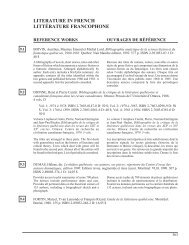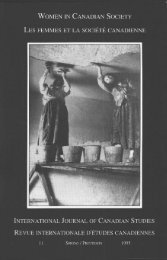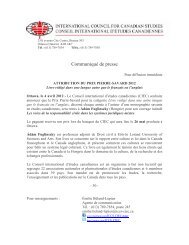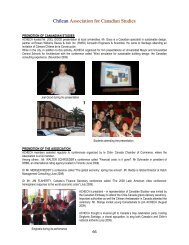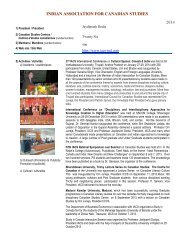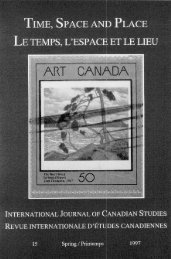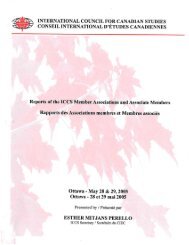Arts and Literature in Canada:Views from Abroad, Les arts et la ...
Arts and Literature in Canada:Views from Abroad, Les arts et la ...
Arts and Literature in Canada:Views from Abroad, Les arts et la ...
- No tags were found...
You also want an ePaper? Increase the reach of your titles
YUMPU automatically turns print PDFs into web optimized ePapers that Google loves.
Refigur<strong>in</strong>g the Mother: Quebec Women Writers <strong>in</strong> the 80sbe suffocat<strong>in</strong>g for both of them. Deny<strong>in</strong>g the weighty responsibilities ofmotherhood is a way of oppos<strong>in</strong>g the seem<strong>in</strong>gly unavoidable loss of self.Here, as elsewhere <strong>in</strong> contemporary women’s fiction, repression of thematernal l<strong>in</strong>gers on even outside the patriarchal family plot. Stanton’snarrative focuses on the surfac<strong>in</strong>g of the maternal voice, which comes <strong>in</strong>tobe<strong>in</strong>g quite naturally while <strong>in</strong> dialogue with others. Narrated <strong>in</strong> the omniscientthird person, Stanton makes extensive use of <strong>in</strong>direct discourse to reveal themother’s personal reflections <strong>and</strong> hidden emotions. This technique opens uptextual spaces where Janou’s maternal thoughts <strong>and</strong> feel<strong>in</strong>gs can be expressedto the reader even when they contradict what is be<strong>in</strong>g asserted <strong>in</strong> conversationswith her daughter, lover <strong>and</strong> friends. For Stanton, reconstruct<strong>in</strong>g the mothermeans mediat<strong>in</strong>g contradictions <strong>in</strong> the external <strong>and</strong> <strong>in</strong>ternal discourse onmotherhood <strong>in</strong> her text.In Ma fille comme une amante, Stanton rep<strong>la</strong>ces the overd<strong>et</strong>erm<strong>in</strong>edpatriarchal mother (cf. Brossard’s L’Amèr) of traditional fiction with aconfused <strong>and</strong> gropp<strong>in</strong>g maternal subject who realizes that <strong>in</strong>dependencebreeds ambivalence about mother<strong>in</strong>g. Challeng<strong>in</strong>g the d<strong>et</strong>erm<strong>in</strong>ism ofbiology, Stanton contextualizes maternal ambivalence about “le renouementdu premier corps à corps” (p. 78) by track<strong>in</strong>g Janou’s resistance to thesocialization of motherhood. Like Adrienne Rich, however, Janou eventuallyrecognizes that it is “<strong>in</strong> the enormity <strong>and</strong> <strong>in</strong>evitability of this [maternal] lov<strong>et</strong>hat [her] suffer<strong>in</strong>gs lie.” 21 In the end, the novel’s constant mix of conflict<strong>in</strong>gmaternal emotions <strong>and</strong> states of be<strong>in</strong>g underm<strong>in</strong>es the traditionaldichotomization of “good” <strong>and</strong> “bad” mothers. Resentment <strong>and</strong> tenderness,anger <strong>and</strong> protectiveness, self-centredness <strong>and</strong> self-sacrifice are all part ofStanton’s rewritten maternal portrait. In this respect, her novel foreshadowsthe harsher, more pessimistic vision of Nicole Houde <strong>in</strong> whose novels theconditions of poverty <strong>and</strong> motherhood are darkly drawn (La Malentendue[1983] <strong>and</strong> L’Enfant de <strong>la</strong> batture [1988] <strong>in</strong> particu<strong>la</strong>r 22 ).Monique LaRue has given the topic of motherhood serious attention <strong>in</strong> herwrit<strong>in</strong>g as well. But LaRue’s work also goes beyond the privileg<strong>in</strong>g ofmaternal characterization, po<strong>in</strong>t of view <strong>and</strong> domestic circumstance. Indeed,what is strik<strong>in</strong>g about La Cohorte fictive (1986) <strong>and</strong> Copies conformes (1989),her first <strong>and</strong> third novels respectively, is the extent to which the maternalviewpo<strong>in</strong>t not only organizes <strong>and</strong> filters narrative events, but also provides the<strong>et</strong>hical stance <strong>from</strong> which we read <strong>and</strong> evaluate the comp<strong>et</strong><strong>in</strong>g systems ofvalue outl<strong>in</strong>ed <strong>in</strong> each work.LaRue’s first novel is a short birth book <strong>in</strong> which the birth of a child <strong>and</strong> thebirth of a text are consciously <strong>in</strong>terwoven <strong>in</strong> theme as well as form. La Cohortefictive conta<strong>in</strong>s a double, alternat<strong>in</strong>g narrative structure, which shifts back <strong>and</strong>forth <strong>from</strong> a mother’s reflections on her writ<strong>in</strong>g <strong>and</strong> her life with a newborn tobrief episodes <strong>from</strong> the book she has been try<strong>in</strong>g for two years to compl<strong>et</strong>e.Organized around maternal time, the time dur<strong>in</strong>g which Clothilde’s <strong>in</strong>fant119



